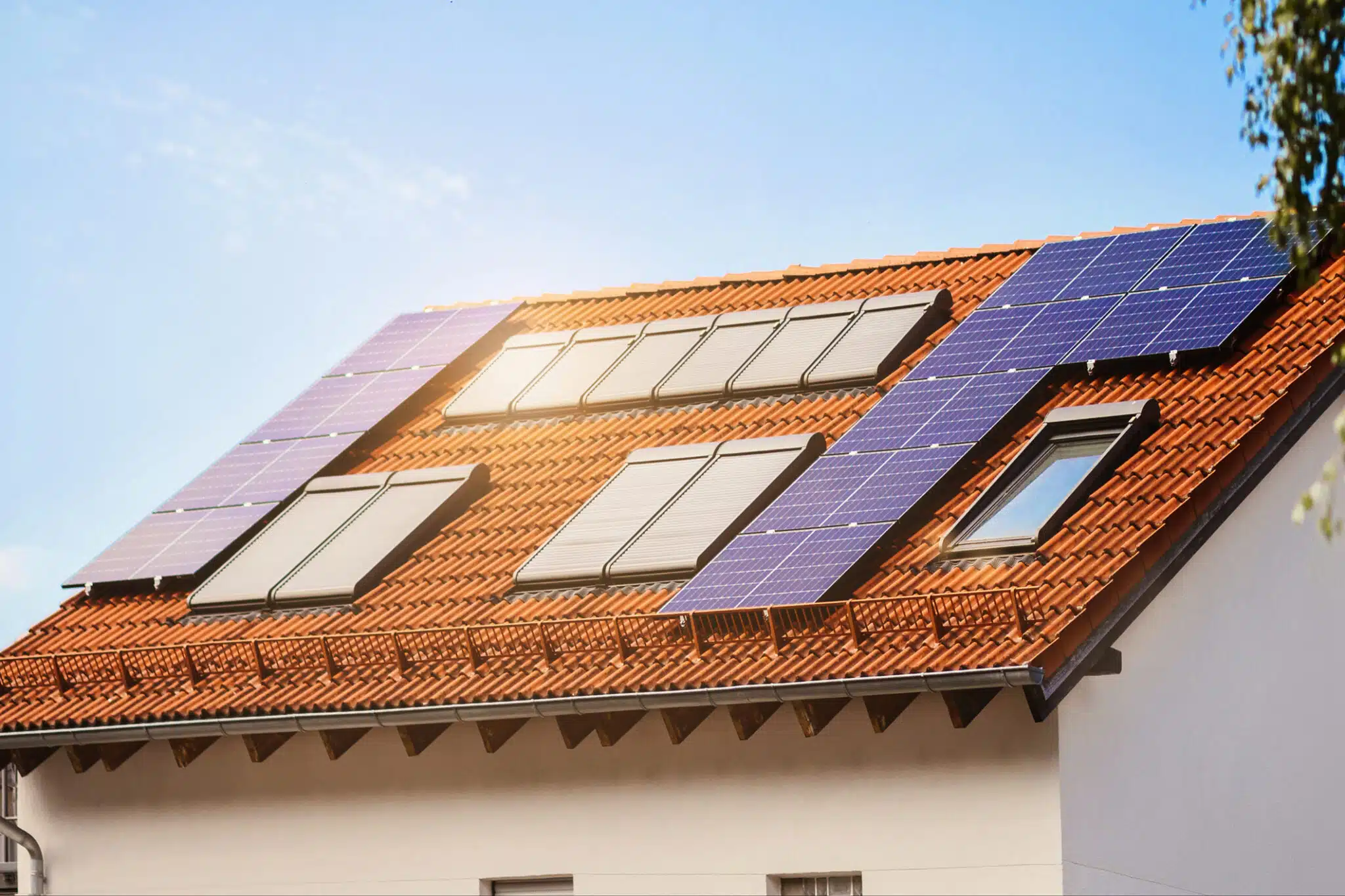Did you know that solar gains can naturally heat your home, cutting down on traditional heating use? This process is particularly effective in colder months, like November, helping homes in Lansdale, PA, stay warmer while reducing energy costs.
By incorporating passive solar design, such as strategically placing south-facing windows, you can capture sunlight more efficiently. This not only maximizes solar heat but also reduces overall energy waste. With proper orientation and materials like thermal mass, solar gains can significantly lower your heating bills.
What is Solar Gain?
Solar gain is the process where sunlight is absorbed and converted into heat, making it an excellent resource for reducing energy costs during colder months. In fact, properly utilizing solar gain can reduce your heating bills by up to 30% in winter. There are two main types of solar gain: passive and active.
- Passive Solar Gain: Homes designed with large, south-facing windows can capture up to 50% more sunlight during the day. This sunlight is absorbed by materials like concrete or brick (thermal mass), which store and slowly release heat. Passive solar heating can reduce your reliance on traditional heating systems by 10% to 25%, depending on your home’s design and insulation.
- Active Solar Gain: Active systems, such as solar panels, directly convert sunlight into energy. By supplementing your heating system with solar power, homeowners can reduce energy costs by another 20% to 30%. These systems are particularly useful during sunny winter days when the sun is low in the sky, providing consistent energy despite shorter daylight hours.
In cities like Lansdale, PA, where winters are cold, maximizing solar gain—especially in November—helps reduce energy consumption. With the right design and technology, solar gain not only cuts heating costs but also contributes to a more sustainable, energy-efficient home.

Passive Solar Heating Explained
Passive solar heating is an efficient and cost-effective way to harness the sun’s energy to naturally warm your home. Unlike active systems that rely on mechanical equipment, passive solar heating uses your home’s design, orientation, and materials to capture and store heat. Here’s how it works:
Capturing Solar Energy
The key to passive solar heating lies in the design of south-facing windows. These windows capture the most sunlight during the winter months when the sun is lower in the sky. Homes built with large, well-insulated south-facing windows can capture up to 60% more sunlight, turning it into valuable heat.
Thermal Mass for Heat Storage
Once the sunlight enters your home, it is absorbed by materials like brick, concrete, or tile, known as thermal mass. These materials store heat throughout the day and slowly release it as the indoor temperature cools in the evening. This method allows homeowners to maintain a stable indoor temperature, reducing the need for traditional heating systems by as much as 25%.
Natural Heat Distribution
Passive solar heating systems are designed to distribute heat evenly throughout your home. Without mechanical devices, heat is transferred naturally as the thermal mass radiates warmth. Proper insulation is essential to ensure that heat doesn’t escape during the night, making the system more efficient.
Balancing with Shading
To prevent overheating during warmer months, passive solar designs also include elements like roof overhangs or deciduous trees. These features provide natural shading, ensuring that homes remain comfortable year-round without excess heat buildup.
With passive solar heating, homeowners can reduce energy consumption, lower heating bills by 10% to 30%, and decrease their carbon footprint. It’s a simple yet highly effective solution for making homes more energy-efficient while benefiting from the sun’s natural warmth.
Active Solar Heating Systems
Active solar heating systems are an effective way to harness solar gains and convert them into usable heat, making homes more energy-efficient. Unlike passive solar heating, which relies on building design, active systems use mechanical equipment to collect and distribute heat.
-
Solar Collectors
Solar collectors are the first key component. They absorb sunlight and transform it into heat. These collectors, often placed on rooftops, capture solar gains by heating a fluid—usually water or antifreeze. Flat-plate collectors or evacuated tube systems are popular options, both designed to maximize the amount of heat gained from the sun.
-
Heat Transfer and Storage
After the fluid absorbs solar gains, it is transported to a heat storage system. A well-insulated water tank stores the heated fluid, ensuring that solar energy can be used even after the sun sets. In colder months, when heating demand is high, stored solar gains can provide substantial energy savings, potentially reducing heating costs by up to 40%.
-
Distribution System
Once heat is stored, it is distributed throughout the home using a mechanical system like a pump or fan. Radiant floor heating, baseboard heaters, or forced air systems ensure solar gains are efficiently spread, maintaining consistent warmth. These systems can significantly lower the need for conventional heating methods, reducing energy use and carbon emissions.
-
Backup Systems
While solar gains can provide a significant amount of heat, they might not always meet 100% of your heating needs, especially in areas with long, cloudy winters. Therefore, active solar systems often include a backup heating source, such as a gas or electric furnace, ensuring consistent indoor comfort regardless of sunlight availability.
Effectively harnessing solar gains through active solar heating allows homeowners to drastically cut energy consumption while reducing their environmental impact. These systems provide long-term financial savings, making them a smart investment for homeowners who prioritize sustainability and energy efficiency.
Solar Gains in November: Why Timing Matters
Solar gains are particularly impactful in November due to the seasonal shift in sunlight availability and heating needs. As temperatures drop and daylight hours shorten, homes rely more on heating to stay warm, making solar gains a crucial energy source during this time.
Sun Angle and Duration
In November, the sun sits lower in the sky, which changes the angle at which sunlight enters your home. South-facing windows are most effective at capturing sunlight, allowing for maximum solar gains during the day. Although days are shorter, the low sun angle helps sunlight penetrate deeper into rooms, warming them naturally.
Increased Heating Demand
As outdoor temperatures decrease, the need for indoor heating rises. By capturing solar gains during the day, homes can reduce their dependence on traditional heating systems. This is especially beneficial in cities like Lansdale, PA, where winters can be cold, and reducing energy costs becomes a priority. Solar gains can provide up to 30% of a home’s heating needs, depending on the design and window placement.
Energy Savings
November is the perfect time to optimize solar gains because it’s the transition period into the colder months. By harnessing sunlight during the day, homeowners can store and distribute the heat throughout the evening, reducing the amount of energy required for heating. This can lead to significant savings on heating bills, particularly in areas with consistent winter sunlight.
In short, November is a key month for maximizing solar gains, as it allows homeowners to harness natural heat at a time when they need it most. By using passive or active solar systems, they can reduce heating costs and improve energy efficiency during the colder season.
The Role of Windows in Capturing Solar Gains
Windows are vital in capturing solar gains, turning sunlight into usable heat that can warm your home naturally. Their effectiveness in this role depends on strategic placement, size, glazing type, and insulation, all of which work together to optimize energy efficiency.
-
Strategic Orientation
South-facing windows are the most effective at capturing solar gains, especially during the winter months when the sun is lower in the sky. These windows can maximize sunlight exposure, allowing heat to penetrate deeper into your home. By positioning large windows on the south side of a building, homes can achieve up to a 30% reduction in heating needs due to increased solar gains.
-
Window Size and High-Performance Glass
Larger windows naturally allow more sunlight to enter, but the type of glass plays a crucial role in energy retention. Windows with a high Solar Heat Gain Coefficient (SHGC) are specifically designed to transmit more solar energy, making them ideal for colder climates. Double- or triple-pane windows with Low-E (low emissivity) coatings improve heat retention by trapping solar gains inside while minimizing heat loss through the glass.
-
Effective Insulation and Window Treatments
Proper insulation around windows and energy-efficient frames are essential for reducing heat loss. In addition, window treatments like insulated blinds or thermal curtains can help manage solar gains. By keeping them open during the day, sunlight can flood into the room, while closing them at night traps the heat inside. This simple practice can enhance energy savings by preventing heat from escaping.
By incorporating well-placed windows with the right materials and treatments, homeowners can maximize solar gains, reducing their reliance on traditional heating methods and cutting down on energy costs. Thoughtful design not only increases comfort but also contributes to a more sustainable, eco-friendly home.
Impact on Heating Bills
Solar gains can significantly reduce your heating bills, especially in colder months when heating demand is at its peak. By capturing sunlight and converting it into heat, you can drastically cut down on your reliance on traditional heating methods. Here’s how solar gains can impact your energy costs:
Maximizing Passive Solar Gains
Homes designed to take advantage of passive solar gains can reduce heating costs by up to 30%. South-facing windows allow sunlight to flood the interior, naturally warming the home during the day. Materials like concrete or brick, which act as thermal mass, absorb this heat and release it slowly as the temperature cools in the evening. With proper insulation, homes can retain solar gains, reducing the need for conventional heating sources.
Active Solar Heating Systems
When combined with active solar systems, such as solar collectors that convert sunlight into energy, heating bills can be slashed by an additional 20% to 40%. These systems efficiently capture solar gains and distribute the heat throughout the home via radiant floor heating, forced air systems, or baseboard heaters. The ability to store solar energy for use after sunset means homes can stay warm even on colder nights.
Sustained Year-Round Savings
While the benefits of solar gains are most evident in winter, their impact on heating bills is year-round. Even in transitional seasons like fall and early spring, solar gains reduce the need for artificial heating, helping to cut energy consumption throughout the year. This results in long-term savings, both in energy costs and reduced wear on heating systems.
Effectively utilizing solar gains through both passive and active systems enables homeowners to dramatically lower heating bills while reducing their environmental impact. Solar energy provides a sustainable heating solution, offering not only eco-friendly benefits but also a significant return on investment, delivering long-term savings and increased home energy efficiency.
Common Challenges with Solar Heating
While solar heating offers many advantages, there are key challenges that homeowners should address to fully benefit from solar gains. Understanding these issues can help improve system efficiency and optimize energy savings.
-
Weather Dependency
Solar heating heavily depends on the availability of sunlight. Cloudy days and short winter daylight hours can limit the amount of solar gains captured, reducing heating efficiency. While active systems with thermal storage can compensate, they still rely on adequate sunlight, which varies by region and season.
-
High Upfront Costs
The initial investment in solar heating systems, including solar collectors, heat storage tanks, and installation, can be significant. Though solar gains provide long-term savings, the upfront costs can be a financial barrier for many homeowners. However, government incentives and rebates can make these systems more affordable over time.
-
Space and Location Limitations
Active solar systems require sufficient roof space for collectors and interior space for storage tanks. Homes with limited roof area or insufficient sunlight exposure may find it challenging to optimize solar gains. Ensuring collectors are placed in sunlit areas without shade is crucial for maximizing energy capture.
-
Backup Heating Systems
Solar heating may not meet all of a home’s heating needs, especially during prolonged cloudy periods or extreme cold. In many climates, homeowners will still need supplemental heating systems, such as gas or electric furnaces, to ensure continuous warmth throughout the winter.
By addressing these challenges, homeowners can make the most of solar heating systems and significantly reduce their reliance on traditional energy sources, achieving long-term savings and contributing to a more sustainable future.
Practical Tips for Maximizing Solar Gains
Maximizing solar gains can significantly reduce your energy bills and enhance your home’s heating efficiency. Here are practical and unique tips to help you make the most of the sun’s energy:
-
South-Facing Windows
Prioritize south-facing windows to capture maximum sunlight, especially in winter. These windows can increase solar gains by up to 50%, reducing the need for artificial heating. Larger windows on the south side allow for deeper penetration of sunlight into the home.
-
High-Performance Glass
Install windows with a high Solar Heat Gain Coefficient (SHGC). Double- or triple-pane glass with Low-E coatings optimizes solar gains by trapping more heat inside, keeping your home warmer during colder months. This upgrade can reduce heating demands by up to 25%.
-
Thermal Mass Materials
Use thermal mass materials like stone or concrete for floors and walls. These materials absorb and store solar energy during the day, releasing it slowly at night to maintain a steady indoor temperature. This natural heat retention can further lower your reliance on traditional heating systems.
-
Insulating Window Treatments
Use thermal curtains or insulated blinds. Open them during the day to capture solar heat, and close them at night to trap warmth, effectively increasing the efficiency of your heating system.
-
Unblock Sunlight
Keep windows clean and remove obstructions like overgrown trees or tall shrubs. Direct, unfiltered sunlight is essential to maximize solar gains, so make sure nothing blocks the rays from entering your home.
-
Seasonal Shading
Consider using roof overhangs or deciduous trees to control sunlight. In summer, these features provide shade, while in winter, they allow maximum sunlight to pass through, helping to balance solar gains year-round.
Incorporating these strategies will allow you to take full advantage of solar gains, reducing heating costs and improving your home’s energy efficiency. By capitalizing on sunlight, you create a home that stays warmer naturally, cutting down on the need for conventional heating systems and promoting sustainable living. These measures not only lower energy bills but also enhance comfort, making your home more environmentally friendly and cost-effective throughout the year.

FAQ
-
How much can solar gains reduce heating bills?
Solar gains can reduce heating bills by 20% to 30%, depending on the home’s design, window orientation, and insulation quality.
-
Do I need special windows for solar gains to work?
Special windows with a high Solar Heat Gain Coefficient (SHGC) are recommended for maximizing solar gains. Double-pane or triple-pane windows with Low-E coatings enhance heat retention.
-
Can solar gains be used alongside traditional heating systems?
Yes, solar gains can work in combination with traditional systems, reducing the load on them during sunny periods and ensuring backup heating is available when needed.
-
What happens to solar gains on cloudy days?
Solar gains decrease on cloudy days, but homes with heat storage systems can retain some of the captured energy for use during less sunny periods.
-
How do I know if my home is suitable for solar gains?
Homes with south-facing windows, minimal shading, and proper insulation are ideal for maximizing solar gains.
Maximizing solar gains lowers heating costs and boosts energy efficiency. At One Hour Heating & Air Conditioning of Lancaster, PA we offer tailored solutions to help you achieve these benefits. Contact us today to start saving and create a more sustainable home!





